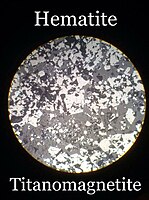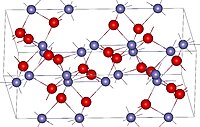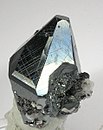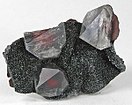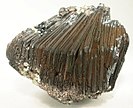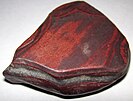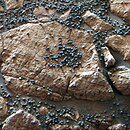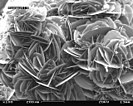Hematite
| Hematite | ||
|---|---|---|
Specific gravity 5.26 | | |
| Density | 5.3 | |
| Optical properties | Uniaxial (−) | |
| Refractive index | nω = 3.150–3.220, nε = 2.870–2.940 | |
| Birefringence | δ = 0.280 | |
| Pleochroism | O: brownish red; E: yellowish red | |
| References | [3][4][5] | |
Hematite (/ˈhiːməˌtaɪt, ˈhɛmə-/), also spelled as haematite, is a common iron oxide compound with the formula, Fe2O3 and is widely found in rocks and soils.[6] Hematite crystals belong to the rhombohedral lattice system which is designated the alpha polymorph of Fe
2O
3. It has the same crystal structure as corundum (Al
2O
3) and ilmenite (FeTiO
3). With this it forms a complete solid solution at temperatures above 950 °C (1,740 °F).
Hematite naturally occurs in black to steel or silver-gray, brown to reddish-brown, or red colors. It is
Large deposits of hematite are found in banded iron formations. Gray hematite is typically found in places that have still, standing water or mineral hot springs, such as those in Yellowstone National Park in North America. The mineral can precipitate in the water and collect in layers at the bottom of the lake, spring, or other standing water. Hematite can also occur in the absence of water, usually as the result of volcanic activity.
Etymology and history
The name hematite is derived from the Greek word for blood αἷμα (haima), due to the red coloration found in some varieties of hematite.[6] The color of hematite is often used as a pigment. The English name of the stone is derived from Middle French hématite pierre, which was taken from Latin lapis haematites c. the 15th century, which originated from Ancient Greek αἱματίτης λίθος (haimatitēs lithos, "blood-red stone").
Ochre is a clay that is colored by varying amounts of hematite, varying between 20% and 70%.[8] Red ochre contains unhydrated hematite, whereas yellow ochre contains hydrated hematite (Fe2O3 · H2O). The principal use of ochre is for tinting with a permanent color.[8]
The
Rich deposits of hematite have been found on the island of
Underground hematite mining is classified as carcinogenic hazard to humans. [12]
Magnetism
Hematite shows only a very feeble response to a
The magnetic structure of α-hematite was the subject of considerable discussion and debate during the 1950s, as it appeared to be ferromagnetic with a Curie temperature of approximately 1,000 K (730 °C), but with an extremely small
Enhanced
-
A microscopic picture of hematite
-
Crystal structure of hematite
Mine tailings
Hematite is present in the waste
Mars

The spectral signature of hematite was seen on the planet
Jewelry
Hematite is often shaped into beads, tumbling stones, and other jewellery components.
Pigment
Hematite has been sourced to make pigments since earlier origins of human pictorial depictions, such as on cave linings and other surfaces, and has been continually employed in artwork through the eras. It forms the basis for red, purple and brown iron-oxide pigments, as well as being an important component of ochre, sienna and umber pigments.[28]
Industrial purposes
As mentioned earlier, hematite is an important mineral for iron ore. The physical properties of hematite are also employed in the areas of medical equipment, shipping industries and coal production. Having high density and capable as an effective barrier for X-ray passage, it is often incorporated into radiation shielding. As with other iron ores, it is often a component of ship ballasts for its density and economy. In the coal industry, it can be formed into a high specific density solution, to help separate coal powder from impurities.[29]
Gallery
-
A rare pseudo-scalenohedral crystal habit
-
Three gemmy quartz crystals containing bright rust-red inclusions of hematite, on a field of sparkly black specular hematite
-
Golden acicular crystals of rutile radiating from a center of platy hematite
-
Cypro-Minoan cylinder seal (left) made from hematite with corresponding impression (right), approximately 14th century BC
-
A cluster of parallel-growth, mirror-bright, metallic-gray hematite blades from Brazil
-
Hematite carving, 5 cm (2 in) long
-
Hematite, variant specularite (specular hematite), with fine grain shown
-
Red hematite from banded iron formation in Wyoming
-
Hematite on Mars as found in form of "blueberries" (named by NASA)
-
Streak plate, showing that Hematite consistently leaves a rust-red streak.
-
Hematite in Scanning Electron Microscope, magnification 100x.
-
Micaceous hematite taken with permission from Kelly's Mine, Lustleigh, Devon UK
See also
References
- ISBN 9780521000987.
- S2CID 235729616.
- ISBN 978-0962209727. Retrieved December 22, 2018.
- ^ "Hematite Mineral Data". WebMineral.com. Retrieved December 22, 2018.
- ^ "Hematite". Mindat.org. Retrieved December 22, 2018.
- ^ LCCN 96031931. Retrieved December 22, 2018.
- ^ a b Morgenthau, Mengo L. (1923). Minerals and Cut Stones: Reference Book Containing Condensed and Simplified Descriptions from Standard Works on Mineralogy. p. 23.
- ^ a b "Ochre". Industrial Minerals. Minerals Zone. Archived from the original on November 15, 2016. Retrieved December 22, 2018.
- ^ "Researchers find earliest evidence for modern human behavior in South Africa" (Press release). AAAS. ASU News. October 17, 2007. Retrieved December 22, 2018.
- ^ Levato, Chiara (2016). "Iron Oxides Prehistoric Mines: A European Overview" (PDF). Anthropologica et Præhistorica. 126: 9–23. Retrieved December 22, 2018.
- .
- ^ https://monographs.iarc.who.int/list-of-classifications
- .
- .
- S2CID 94031594.
- S2CID 137598876.
- ^ Redman, Chris (May 20, 2009). "The next iron rush". Money.cnn.com. Retrieved December 22, 2018.
- ^ "Sveriges mest beprövade husfärg" [Sweden's most proven house color] (in Swedish). Retrieved December 22, 2018.
- ^ "Mars Global Surveyor TES Instrument Identification of Hematite on Mars" (Press release). NASA. May 27, 1998. Archived from the original on May 13, 2007. Retrieved December 22, 2018.
- .
- .
- S2CID 53489327.
- Bibcode:2005LPI....36.2159G.
- ^ "Hematite". NASA. Retrieved December 22, 2018.
- ^ "Hematite: A primary ore of iron and a pigment mineral". geology.com. Retrieved 2023-09-07.
- ISBN 978-1-55297-814-6.
- ^ "Magnetic Hematite". Mindat.org. Retrieved December 22, 2018.
- ^ "Colors from the Earth: Violet Hematite". www.naturalpigments.com. Retrieved 2023-09-07.
- ^ "Hematite: A primary ore of iron and a pigment mineral". geology.com. Retrieved 2023-09-07.

